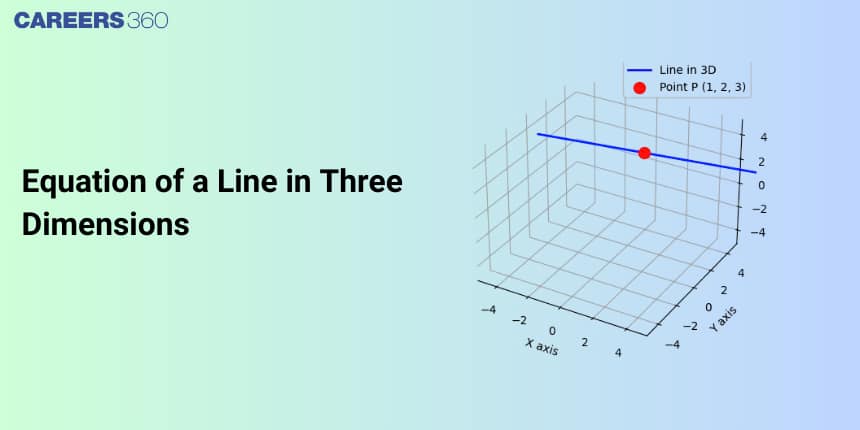Equation of a Line in Three Dimensions
The equation of a line is an algebraic way to represent a line in terms of the coordinates of the points it joins. The equation of the straight line in 3D requires two points that are located in space. The point in three coordinates is expressed as (
JEE Main: Study Materials | High Scoring Topics | Preparation Guide
JEE Main: Syllabus | Sample Papers | Mock Tests | PYQs
- What is the Equation of a Line?
- Equation of line in 2D
- Equation of a line through a given point and parallel to a given vector in Vector Form
- Equation of a line through a given point and parallel to a given vector in Cartesian Form
- Equation of a line passing through two given points in vector form
- Solved Examples Based on Equations for a Line in 3D Space

In this article, we will cover the concept of Equations for a Line in Space. This topic falls under the broader category of 3-dimensional geometry, which is an important chapter in Class 12 Mathematics. This is very important not only for board exams but also for the competitive exams, which even include the Joint Entrance Examination Main and other entrance exams: SRM Joint Engineering Entrance, BITSAT, WBJEE, and BCECE. A total of 11 questions have been asked on this topic in JEE Main from 2013 to 2023 including one in 2014, one in 2019, two in 2021, two in 2022, and five in 2023.
What is the Equation of a Line?
The equation of a line is an algebraic way to express a line in terms of the coordinates of the points it joins. The equation of a line will always be a linear equation.
A line is uniquely determined if:
It passes through a given point and has given direction, or
It passes through two given points.
Equation of line in 2D
1) Point Slope Form
Using the Point Slope Form we represent a line using the slope
2) Slope Intercept Form
In Slope Intercept Form we represent a line using the slope
3) Intercept Form
Using the Intercept Form we represent a line where it intersects the x -axis at
4) Normal Form
Represents a line using the angle
Equation of Line in 3D
The equation of the straight line in 3D requires two points that are located in space. The point in three coordinates is expressed as (
Equation of a line through a given point and parallel to a given vector in Vector Form
Let

Using vector operations, we can rewrite,
Setting
Equation of a line through a given point and parallel to a given vector in Cartesian Form
The Equation of a line through a given point and parallel to a given vector in Cartesian Form is
Derivation
The vector equation of a line
If we solve each of these equations for the component variables
If we solve each of the equations for
|These are parametric equations of the line. Eliminating the parameter
This is the Cartesian equation of the line.
NOTE:
If
Equation of a line passing through two given points in vector form
Let
Derivation
Let
Let

Using P as our known point on the line, and
Equation of a line passing through two given points in Cartesian Form
We can also find parametric equations for the line segment
As the position vector of point
Recommended Video Based on Equations for a Line in 3D Space
Solved Examples Based on Equations for a Line in 3D Space
Example 1: Consider the lines
line
[JEE MAINS 2023]
Solution

D R's of
Hence, the answer is
Example 2: Let the line
[JEE MAINS 2023]
Solution
Hence, the answer is
Example 3: Let a line having direction ratios
Solution
Direction ratio of AB:
On solving
Hence, the answer is 84
Example 4: The equation of the line through the point
Solution

Since,
So,
Hence, the answer is
Example 5 : The equation of the line passing through
[JEE Mains 2021]
Solution: The normal vector of the plane containing two intersecting lines is parallel to the vector
Frequently Asked Questions (FAQs)
A line is uniquely determined if It passes through a given point and has given direction, or it passes through two given points.
The Cartesian equation of a line is given by
If I, m, n are the direction cosines of the line, the equation of the line is
The equation of the line passing through two points is given by
The equation of a line passing through two points
Also Read
15 Feb'25 01:59 AM
15 Feb'25 12:41 AM
15 Feb'25 12:40 AM
15 Feb'25 12:25 AM
15 Feb'25 12:23 AM
15 Feb'25 12:19 AM
15 Feb'25 12:10 AM
15 Feb'25 12:07 AM
15 Feb'25 12:05 AM




